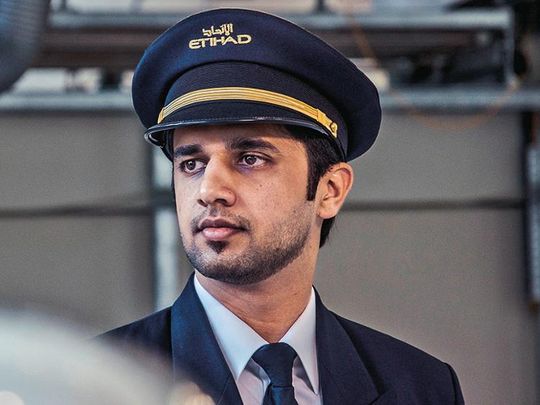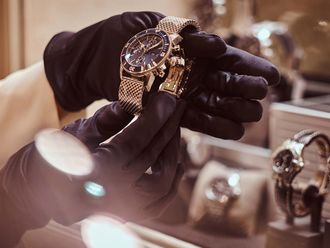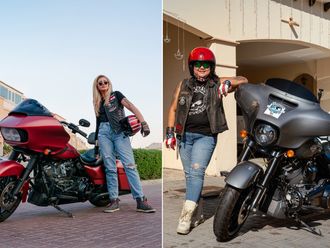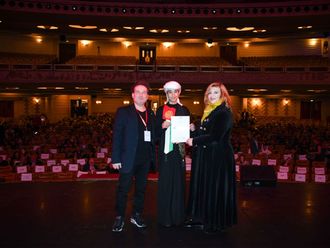
What’s your very first memory of aeroplanes as a child, Hassan?
I remember back in 1988 when I was just a young boy my father was coming home from the pilgrimage in Saudi Arabia and he bought me a model of a 747. I was fascinated by it and that really stuck in my mind throughout my life.
How did you eventually learn to fly?
It can be really hard to become a pilot, especially if the airline doesn’t run a cadet pilot programme. Luckily Etihad does, so it was perhaps a bit easier for me, although it still takes a lot of training and commitment – you have to be away from your family for a long time. Etihad’s course is unique, and first puts us through a university school to do a Bachelor’s degree in Aviation Science before we get to the flying phase. It takes around seven years to accomplish, which is a lot longer than the 18 months it takes to get a normal ATPL [Airline Transport Pilot Licence] private licence to be a commercial pilot.
What do you fly?
I fly the Airbus A320 family: the A319, the A320 and the A321.
What’s it like to sit ‘behind the wheel’ of one of the most expensive vehicles on Earth?
You have the control – that’s what we say: the captain will say, ‘You have control’ and when that happens the aircraft is all yours: it’s a real responsibility. You’re flying almost a AED 400 million aircraft and you feel responsible for the people behind you – they put their trust in you. It’s both a responsibility and an honour.
What happens before take-off?
The captain and I have our briefings and we are thinking about the whole safety of the flight: will we encounter any turbulence ahead? Do we have any special guests or passengers who need special care? We think about all of these things so that we can eliminate any problems one by one. The more we are under control the more confident we feel about everything.
How many people are in the cockpit with you?
Aircraft on ultra-long-haul flights like the A380s have three or four crew, but our flights on the 320 series last a maximum of seven hours and there are two of us. It was three back in the 1980s, the third being a flight engineer, but computers now do that job.
How do you start the engine? We’re guessing you don’t have a big key...
No, it’s more of a button. Starting the engines is a dynamic thing: the engines need air and a spark plug plus fuel, so I send air to the engines by pressing the start button. The engines will start pressurizing the air through high pressure compressors and that will take the air to the combustion chamber for igniting.
The perception of airliners is that they are astonishingly complex with thousands of switches – what’s the reality?
There are lots of switches as airplanes get more and more sophisticated. As pilots, our job is to monitor what the airplane does: pilots don’t actually fly the plane from, say, London to New York, it’s only during the take-off and landing that they are doing that. The more buttons we have, the more we can improve safety. It also means pilots never stop learning.
Do you ever sleep in the cockpit?
We have what we call controlled naps in the cockpit; I will hand over to the captain the communication and the control and take a nap for a maximum of 40 minutes, and I have to be alert one hour before the descent so that I feel refreshed for that phase. On ultra-long-haul flights they have a place at the back of the cabin where members of both the flight deck and cabin crew can sleep for up to seven hours.
Can you eat whatever you like from the in-flight menu?
When you’re constantly flying, you can get quite bored of airline food, so sometimes I bring my own.
What are some of the most impressive statistics you like to reel off about the aeroplanes you fly?
The speed is definitely one. When we get a tail wind we can reach 0.8 Mach, which is 600 miles per hour. We always like getting a tail wind. We also like to talk about how many safe take-off and landings we’ve had without having to have a go-around: which is when you have to go around again – for whatever reason – instead of landing. For me, I’ve never had a go-around.
Given that you’re adept at flying such an amazing machine, could you easily slide into the cockpit of a jet from the 1960s and find yourself able to fly it?
Back in those days the airplanes were much more based on levers and pulleys, not like the hydraulic systems that we have today. Now we make a very small adjustment and the hydraulics do the job, and on the 787 Dreamliner they even have electronics to do that. It would be challenging to fly an old jet, but starting it and everything else is the same concept.
What’s the most amazing aircraft you’ve ever flown?
That would be the E-300 in flying school, which was more of an aerobatic airplane. It’s a unique programme we have where we get to encounter 6-7Gs – because you don’t know at flight school what type of aircraft you’re going to end up flying. My dream aircraft to fly would be a 747. They’re phasing them out because of their fuel consumption and other things, but I really like that airplane and I would love the chance to fly it, not least because it was a 747 model that my father bought me all those years ago.
What’s your favourite view from the cockpit?
I like flying into Moscow, especially in the winter, because as you approach it’s all white. It’s white everywhere, and the only thing you can see is a black strip where you have to land the airplane. It’s like something from the movies, and obviously it’s completely different to the kind of environment we normally see here in the UAE.
They say that pilots are more likely than anyone to spot a UFO – any stories?
They might see the aurora borealis on long-haul flights that go close to the north pole, but along the equator there’s nothing, I’m telling you!
Modern jetliners are huge – but are they also quite nimble?
They are nimble – they just need a very small input from us when flying manually, meaning they’re very easy to manoeuvre. But of course it’s a very hard path to be able to do that.
What do you think the future of large commercial aircraft will be in the next 20 years?
Well, Elon Musk is saying he’s going to have a rocket that will get you from the UAE to the US in 40 minutes. That’s a huge achievement, because for people it’s all about time, but it’s also all about safety, and now he has to secure that. I also think in 20 to 30 years there might only be one pilot in the cockpit of an airplane because there are so many back-ups now.
They say that modern aircraft are so advanced they could fly themselves – is that true, and do you think the public would ever be ready for that?
It’s partially true. They fly themselves when we’re on autopilot, but they can’t tell if there’s something ahead, so we constantly have someone monitoring everything and for the critical phases, take-off and landing, we disengage the autopilot. Would people ever want a plane with no pilot? I doubt it.
What was the best reaction you ever got when you told someone you were a pilot?
It tends to come from shopkeepers if I show them my ID; sometimes they ask all sorts of questions about how the planes fly. I try to help them to understand, which is quite difficult because you have to try and do it in a non-technical way. There are probably less than 1,000 licensed pilots in the UAE, so it’s the kind of job that people respect.
Finally, if you had to fly the same route every single day for the rest of your career, what would you choose?
Belgrade. I like the city, I like the culture, the people and the food. And the view is great – we tend to arrive at sunrise, with the sun behind us.











